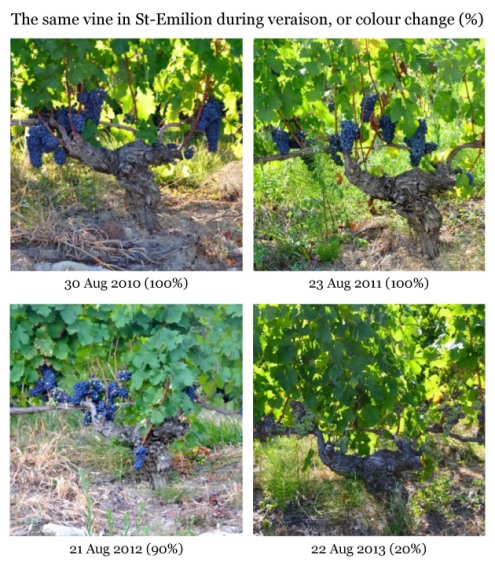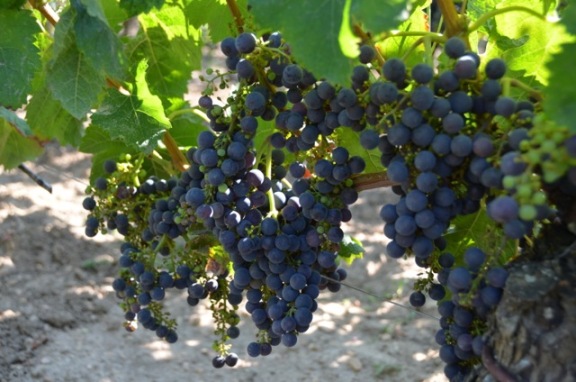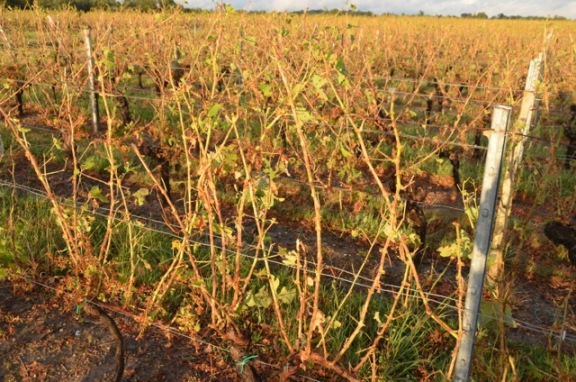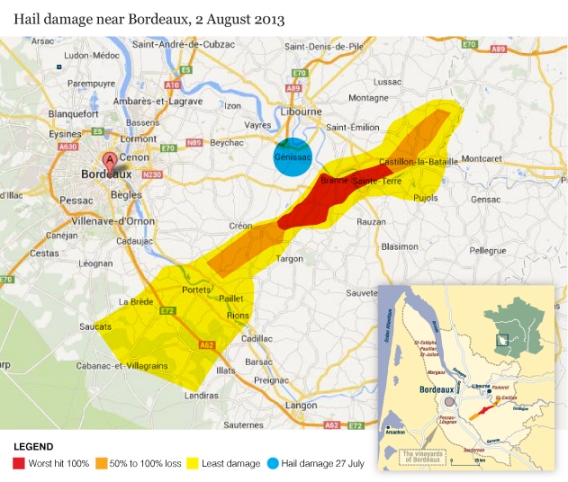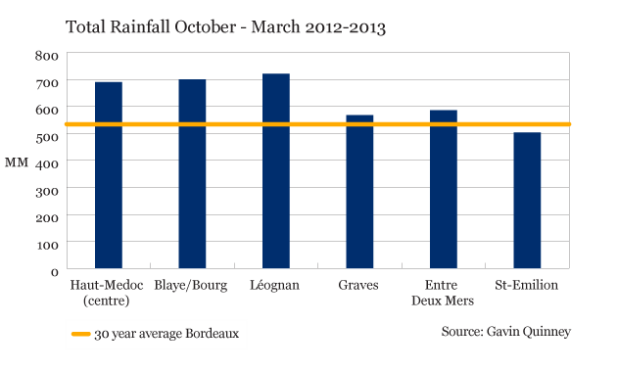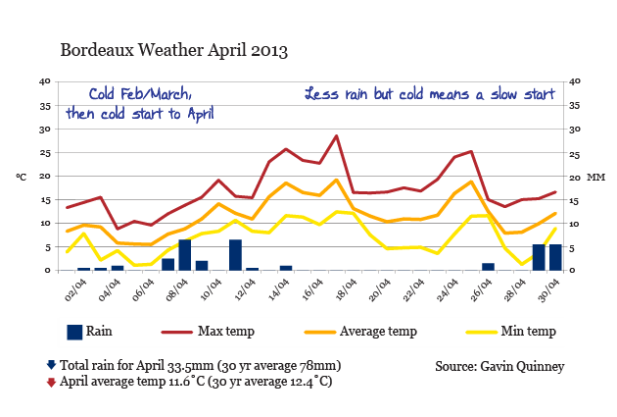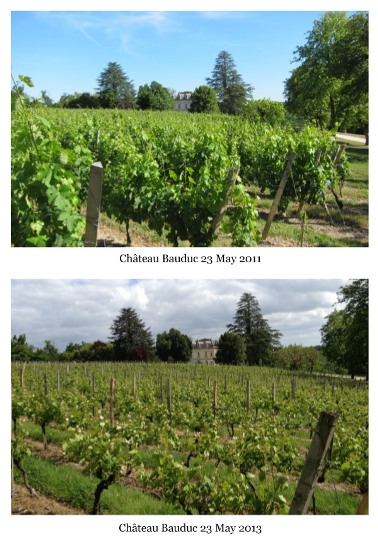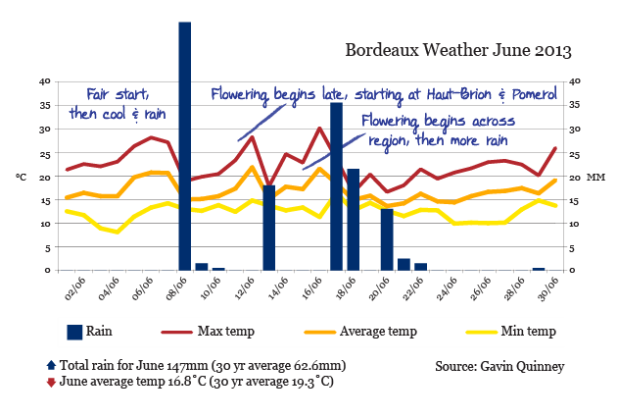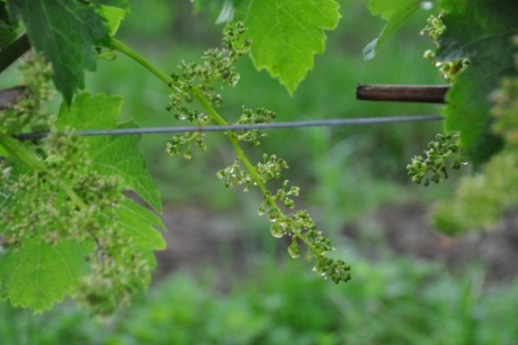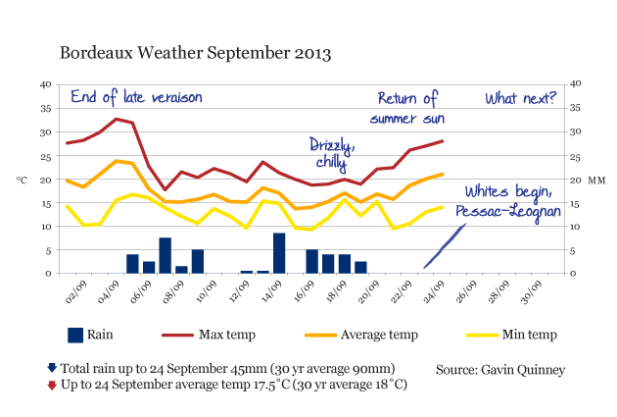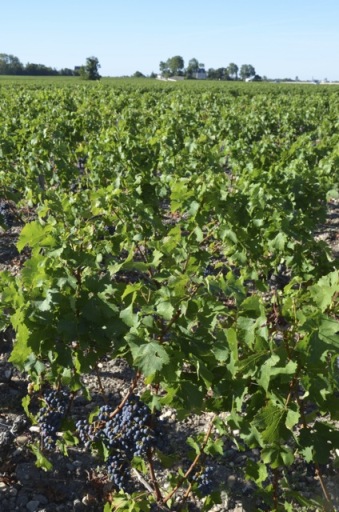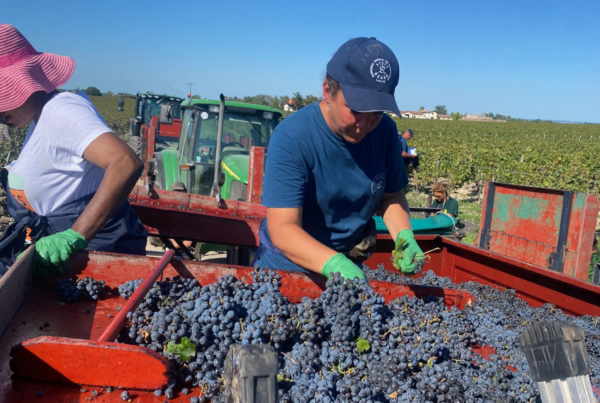As the 2013 harvest gets underway in Bordeaux, Liv-ex has opened up the blog to Bordeaux grower, winemaker and writer Gavin Quinney (@GavinQuinney). In this special report he gives an insider’s view on the weather and growing conditions for the 2013 vintage – and what that could mean for the wine. All photos and images in this article are copyright Gavin Quinney.
Here is a detailed report, as the
Bordeaux harvest begins, on the weather so far this year and the impact on the
vines.
It’s fair to say that my earlier updates on the 2013 growing
season in Bordeaux have been less than enthusiastic. ‘Running late‘ in May, ‘The
flowering‘ in June, ‘Lafite’s weeping willows‘ in July and then, on my own blog
in August, the ‘Hail in Bordeaux’ series of posts hardly paint a rosy picture.
Yet even at this stage at the end of September, this roller
coaster vintage is still too early to call. The weather in October for the red
harvest (Bordeaux is 88% red) will be crucial. Even before then, storms are
forecast for this weekend, after a week of sunshine.
To follow my harvest updates on Twitter, type the following in the search box: from:gavinquinney #bdx13
10 THINGS WE DO KNOW
1. 2013 is an exceptionally late harvest. (Or should be.)
2. 2013 will be a small crop in Bordeaux overall.
3. A cold first half of the year held up growth in the
vineyard.
4. An unusually cold, wet May and downpours in June led to
late, uneven flowering.
5. July was hot and dry, August sunny, September up and
down. October is key.
6. An August hailstorm hit more than 10,000 hectares – about
10% of the Bordeaux vineyard – but none of the top Chateaux.
7. Quality and yields will be extremely variable – the
contrast is evident in the vineyards.
8. The dry white harvest has started well, while prospects
for sweet whites are ‘promising’.
9. The red harvest is likely to be a race against time (and
rot) as the Autumn weather draws in.
10. The advantage lies with those who have the resources and
equipment to be highly selective.
HIGHLIGHTS
A LATE HARVEST
It’s late, even by 2012 standards. I happened to take the below pictures of the same vine on the slope below Chateau Tertre Roteboeuf at the
end of August in recent vintages, which show colour change variation.
SMALL CROP
We began with une belle sortie de grappes – plenty of
potential bunches. But cold and wet weather in May and rain at just the wrong
time in June contributed to poor fruit-set on the Merlot across the region.
Some estates have fared better than others – in fact, some vines performed
much better than their immediate neighbours.
Given that 65% of the red vineyards in Bordeaux are planted
with Merlot, coulure (when grapes don’t form) and millerandage (‘hen and
chick’) have had a significant impact on the crop. Cabernet Sauvignon, which
makes up 23%, is variable while Cabernet Franc – just 10% – flowered most
successfully. The Petit Verdot looks good but late in the Medoc, while Malbec
is patchy on the Right Bank. The whites, and especially Sémillon, look in
better shape.
I haven’t seen such poor flowering, in general, since the
summer of 2002.
To put volumes in perspective, Bordeaux made an average of
5.57 million hectolitres per year from 2006-2010, and 5.25 million hl in 2012.
If yields are down by 24% on 2012 at 4 million hl, that’s the equivalent of 533
million bottles.
HAIL – In the Stalls, not the Royal Circle
Many reports will mention hail as a reason for the lower
crop in 2013. This is partly true but the hailstorms caused heavy losses mainly
in the Entre Deux Mers, the source of much AC Bordeaux and Bordeaux Supérieur.
Of the best known appellations, only St-Emilion was touched on the SE fringe
and none of Bordeaux’s leading Chateaux were hit.
THE WEATHER CHARTS
Rainfall during the winter was slightly over the 30-year
average in most sectors, and the most we’ve had in the last ten winters. We
also had more days when it rained – about 100 depending on the area, compared
to an average of 69 days. December and January were the wettest months.
Monthly temperatures were close to the 30-year average until
February, which was 2°C below average (5.7˚C v 7.7˚C), and March, 1.5°C below
(8.6˚C v 10.1˚C).
After a cold February and March, April saw fluctuating
temperatures. Bud-break was a bit later than usual and morning frosts at the
end of the month were a threat. The rainfall measured here, some 15 miles SE of
the city of Bordeaux, and at nearby St-Emilion, was lower than in other parts of
Bordeaux: there was 60-70mm in the Medoc. But thankfully no repeat of the heavy
April downpours of 2012 (160-200mm).
With March (60mm) and April both having average or lower
rain than the average, I don’t think of the spring of 2013 as being wet. May
and June on the other hand…
MAY – a shocker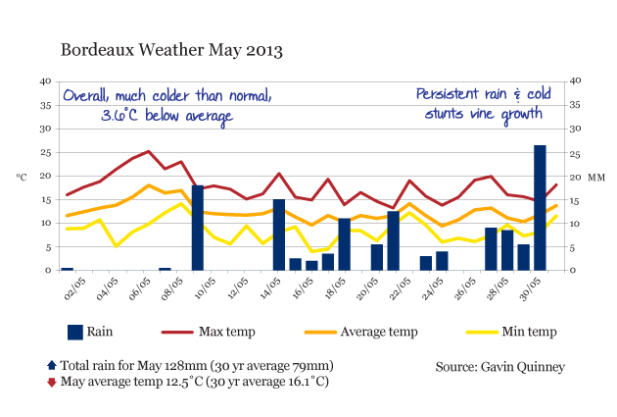 After a promising start, May was fearfully chilly and wet,
After a promising start, May was fearfully chilly and wet,
and the vines never got going. The temperature of the subsoils stayed lower
than in previous vintages in the second half of the month, and this was
reflected in the retarded height of the vine canopy everywhere.
If you add the cumulative average temperatures above 10˚C,
recorded in Léognan from 1 January to 31 May, compared to recent vintages, 2013
is way behind:
2008 347˚, 2009 326˚, 2010 325˚, 2011 492˚, 2012 331˚, 2013
212˚.
Given the correlation between temperature and flowering, and
that mid-flowering occurred around 8-10 June for the 2008, 2009, 2010 and 2012
vintages (20 May for 2011), it’s easy to see why the flowering in 2013 was
going to be much, much later.
JUNE – rain during late flowering
A good first week then heavy rain on 8 June. Then, just as
the vines came into flower, we had much more rain than usual and at the wrong
moment for the floraison, which was already late. It seemed that the vines were
splitting their energies between further growth and flowering at the same time
– in the rain – so poor fruit set on the Merlot was inevitable.
The results are mixed though – some vines are badly affected, whereas a few paces along, the flowering was more successful.
Visitors to Vinexpo might recall a baking Sunday and then a filthy Monday night
and Tuesday. The flowering vines were similarly confused.
JULY – a scorcher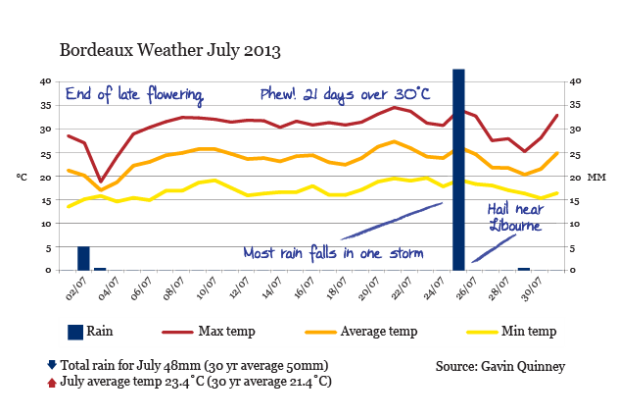 July was a complete contrast to the months before, with 21
July was a complete contrast to the months before, with 21
scorching days over 30°C. The first half and middle of July is rarely so
consistently hot in Bordeaux.
The sun was most welcome to holidaymakers and wine tourists
who, based on this evidence, think that growing grapes must be a doddle.
Most of the rain for the month came with heavy storms on the
night of Friday 25 July. (See Lafite’s weeping willows.) Worse was to fall on Genissac, south of Libourne, with the
first of the summer’s hail.
AUGUST – don’t mention the hail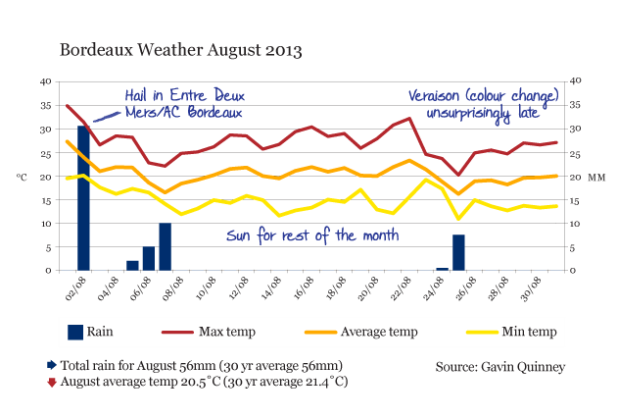
A terrible start to the month for some, with a devastating
storm on the evening of Friday, 2 August. Hail tore through about 10,000
hectares of vines, mainly in the Entre Deux Mers – see the map above. See also
‘Hail in Bordeaux, part 1’ and ‘part 2’.
Fine weather set in after the first week. Veraison was very
late, although this wasn’t surprising given how retarded the floraison had
been. It was the first vintage I’d seen where no grapes had changed colour by
the start of August in the early -ripening vineyards of Pomerol. First signs of
veraison in the Medoc and in St-Emilion were to be seen in the middle of the
month. That’s late.
The grapes are still changing colour in some vineyards at
the start. A bright start to the month, then cool and drizzle. The third week
has seen welcome sunshine, reviving hopes.
At the mid-point, the vineyards are looking green and
healthy. Ready for the long wait ahead?
They start picking the dry whites in Pessac-Léognan in the
sunshine, and even the first pass for Sauternes at Yquem.
Bon courage à tous. We’re going to need it.

